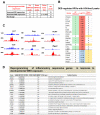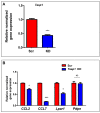Epigenetic Modulation of Inflammatory Pathways in Myometrial Stem Cells and Risk of Uterine Fibroids
- PMID: 37511399
- PMCID: PMC10380326
- DOI: 10.3390/ijms241411641
Epigenetic Modulation of Inflammatory Pathways in Myometrial Stem Cells and Risk of Uterine Fibroids
Abstract
The period during which tissue and organ development occurs is particularly vulnerable to the influence of environmental exposures. However, the specific mechanisms through which biological pathways are disrupted in response to developmental insults, consequently elevating the risk of hormone-dependent diseases, such as uterine fibroids (UFs), remain poorly understood. Here, we show that developmental exposure to the endocrine-disrupting chemical (EDC), diethylstilbestrol (DES), activates the inflammatory pathways in myometrial stem cells (MMSCs), which are the origin of UFs. Significantly, the secretome of reprogrammed MMSCs enhances the expression of critical inflammation-related genes in differentiated myometrial cells through the paracrine mechanism, which amplifies pro-inflammatory and immune suppression signaling in the myometrium. The expression of reprogrammed inflammatory responsive genes (IRGs) is driven by activated mixed-lineage leukemia protein-1 (MLL1) in MMSCs. The deactivation of MLL reverses the reprogramming of IRG expression. In addition, the inhibition of histone deacetylases (HDACs) also reversed the reprogrammed IRG expression induced by EDC exposure. This work identifies the epigenetic mechanisms of MLL1/HDAC-mediated MMSC reprogramming, and EDC exposure epigenetically targets MMSCs and imparts an IRG expression pattern, which may result in a "hyper-inflammatory phenotype" and an increased hormone-dependent risk of UFs later in life.
Keywords: developmental reprogramming; diethylstilbestrol; inflammatory responsive genes; myometrial stem cells; uterine fibroids.
Conflict of interest statement
None of the authors have a financial relationship with a commercial entity that has an interest in the subject of this manuscript.
Figures







Similar articles
-
Endocrine-disrupting chemicals and epigenetic reprogramming in developmental origin of uterine fibroids.Sci Prog. 2023 Oct-Dec;106(4):368504231215601. doi: 10.1177/00368504231215601. Sci Prog. 2023. PMID: 38189295 Free PMC article.
-
Developmental reprogramming of myometrial stem cells by endocrine disruptor linking to risk of uterine fibroids.Cell Mol Life Sci. 2023 Aug 31;80(9):274. doi: 10.1007/s00018-023-04919-0. Cell Mol Life Sci. 2023. Update in: Sci Prog. 2023 Oct-Dec;106(4):368504231215601. doi: 10.1177/00368504231215601. PMID: 37650943 Free PMC article. Updated.
-
Vitamin D3 Ameliorates DNA Damage Caused by Developmental Exposure to Endocrine Disruptors in the Uterine Myometrial Stem Cells of Eker Rats.Cells. 2020 Jun 12;9(6):1459. doi: 10.3390/cells9061459. Cells. 2020. PMID: 32545544 Free PMC article.
-
Early Life Adverse Environmental Exposures Increase the Risk of Uterine Fibroid Development: Role of Epigenetic Regulation.Front Pharmacol. 2016 Mar 1;7:40. doi: 10.3389/fphar.2016.00040. eCollection 2016. Front Pharmacol. 2016. PMID: 26973527 Free PMC article. Review.
-
Endocrine-disrupting chemicals and uterine fibroids.Fertil Steril. 2016 Sep 15;106(4):967-77. doi: 10.1016/j.fertnstert.2016.08.023. Epub 2016 Aug 21. Fertil Steril. 2016. PMID: 27553264 Free PMC article. Review.
Cited by
-
Causal relationship between genetically predicted uterine leiomyoma and cancer risk: a two-sample Mendelian randomization.Front Endocrinol (Lausanne). 2024 Aug 29;15:1429165. doi: 10.3389/fendo.2024.1429165. eCollection 2024. Front Endocrinol (Lausanne). 2024. PMID: 39268242 Free PMC article.
-
The adverse role of endocrine disrupting chemicals in the reproductive system.Front Endocrinol (Lausanne). 2024 Jan 17;14:1324993. doi: 10.3389/fendo.2023.1324993. eCollection 2023. Front Endocrinol (Lausanne). 2024. PMID: 38303976 Free PMC article. Review.
-
Evidence-Based Approach for Secondary Prevention of Uterine Fibroids (The ESCAPE Approach).Int J Mol Sci. 2023 Nov 4;24(21):15972. doi: 10.3390/ijms242115972. Int J Mol Sci. 2023. PMID: 37958957 Free PMC article. Review.
-
Endocrine-disrupting chemicals and epigenetic reprogramming in developmental origin of uterine fibroids.Sci Prog. 2023 Oct-Dec;106(4):368504231215601. doi: 10.1177/00368504231215601. Sci Prog. 2023. PMID: 38189295 Free PMC article.
-
Bromodomain-Containing Protein 9 Regulates Signaling Pathways and Reprograms the Epigenome in Immortalized Human Uterine Fibroid Cells.Int J Mol Sci. 2024 Jan 11;25(2):905. doi: 10.3390/ijms25020905. Int J Mol Sci. 2024. PMID: 38255982 Free PMC article.
References
-
- Segars J.H., Parrott E.C., Nagel J.D., Guo X.C., Gao X., Birnbaum L.S., Pinn V.W., Dixon D. Proceedings from the Third National Institutes of Health International Congress on Advances in Uterine Leiomyoma Research: Comprehensive review, conference summary and future recommendations. Hum. Reprod. Update. 2014;20:309–333. doi: 10.1093/humupd/dmt058. - DOI - PMC - PubMed
MeSH terms
Substances
Grants and funding
LinkOut - more resources
Full Text Sources
Medical
Molecular Biology Databases
Research Materials

